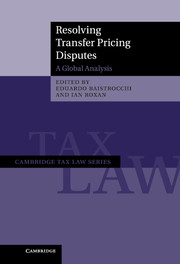Book contents
- Frontmatter
- Contents
- List of figures
- List of tables
- List of contributors
- Acknowledgements
- The Golden Bridge: analytical table of cases by topics in the OECD Guidelines
- Table of Cases
- Abbreviations
- Part I The context of transfer pricing disputes
- Part II North America and Europe
- Part III Asia Pacific
- Part IV BRIC Countries
- 13 Transfer pricing disputes in Brazil
- 14 Transfer pricing disputes in the Russian Federation
- 15 Transfer pricing disputes in India
- 16 Transfer pricing disputes in China
- Part V South America, Middle East and Africa
- Part VI Conclusion
- Index
- References
16 - Transfer pricing disputes in China
from Part IV - BRIC Countries
Published online by Cambridge University Press: 05 November 2014
- Frontmatter
- Contents
- List of figures
- List of tables
- List of contributors
- Acknowledgements
- The Golden Bridge: analytical table of cases by topics in the OECD Guidelines
- Table of Cases
- Abbreviations
- Part I The context of transfer pricing disputes
- Part II North America and Europe
- Part III Asia Pacific
- Part IV BRIC Countries
- 13 Transfer pricing disputes in Brazil
- 14 Transfer pricing disputes in the Russian Federation
- 15 Transfer pricing disputes in India
- 16 Transfer pricing disputes in China
- Part V South America, Middle East and Africa
- Part VI Conclusion
- Index
- References
Summary
Introduction
Transfer pricing is a relatively new issue in the People's Republic of China. China opened its door to foreign investors in the late 1970s and multinational enterprises brought their transfer pricing practices to China. It was not until 1991 that China enacted the first transfer pricing law. As expected, China imported the arm's length principle to deal with the imported transfer pricing problem. Because the Chinese legal culture differs in many respects from that of OECD countries, especially the United States where the arm's length standard originated, adaptation of the OECD-based solution is inevitable. In addition, China's national interest in cross-border transfer pricing matters has changed over the past three decades, which has led to corresponding changes in China's approach to resolving transfer pricing disputes.
Following this introduction, section 16.2 provides a brief cultural and historical context for the arm's length principle in China. Section 16.3 discusses the implementation and administration of the arm's length principle. Section 16.4 examines the resolution of transfer pricing disputes in China under the domestic mechanism and the mutual agreement procedure (MAP) under bilateral tax treaties. In light of the Chinese national interests and existing legal culture, section 16.5 suggests that the future solution of the global transfer pricing problems lies in bilateral or multilateral advance pricing agreements and a pragmatic application of the arm's length principle.
- Type
- Chapter
- Information
- Resolving Transfer Pricing DisputesA Global Analysis, pp. 634 - 666Publisher: Cambridge University PressPrint publication year: 2012



